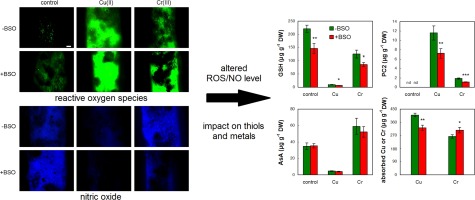Chemosphere ( IF 8.1 ) Pub Date : 2018-03-19 , DOI: 10.1016/j.chemosphere.2018.03.112 Jozef Kováčik , Sławomir Dresler , Viera Peterková , Petr Babula

|
Short-term (24 h) responses of Cladonia arbuscula subsp. mitis (formerly known as Cladina and this name is used to distinguish the tested species) and Cladonia furcata to copper (CuII) or chromium (CrIII) excess (10 or 100 µM) were compared. Cladina accumulated more Cu and Cr at higher metal doses but both species revealed depletion of K and/or Ca amount. Not only Cu but also Cr typically elevated reactive oxygen species (ROS) formation (fluorescence microscopy detection of total ROS and hydrogen peroxide) and depleted nitric oxide (NO) signal, with Cu showing more negative impact on lipid peroxidation (BODIPY 581/591 C11 staining reagent). Metals and staining reagents also affected anatomical responses and photobiont/mycobiont visibility. Principally different impact of Cu and Cr was observed at antioxidative metabolites level, indicating various ways of metal-induced ROS removal and/or metal chelation: Cu strongly depleted glutathione (GSH) and stimulated phytochelatin 2 (PC2) content while ascorbic acid accumulation was depleted by Cu and stimulated by Cr. Subsequent experiment with GSH biosynthetic inhibitor (buthionine sulfoximine, BSO) revealed that 48 h of exposure is needed to deplete GSH and BSO-induced depletion of GSH and PC2 amounts under Cu or Cr excess elevated ROS but depleted NO. These data suggest close relations between thiols, NO and appearance of oxidative stress (ROS generation) under metallic stress also in lichens.
中文翻译:

金属诱导的地面大型地衣中的氧化应激
丛枝小球藻亚种的短期(24小时)反应。比较了Mitis(以前称为Cladina,用这个名字来区分被测物种)和富兰的Cladonia furcata对过量的铜(CuII)或铬(CrIII)(10或100 µM)的情况。克拉迪娜在较高的金属剂量下累积了更多的铜和铬,但两种物质都显示出钾和/或钙的消耗。不仅铜,而且铬通常会增加活性氧(ROS)的形成(荧光显微镜检测总ROS和过氧化氢)并减少一氧化氮(NO)信号,其中Cu对脂质过氧化作用表现出更大的负面影响(BODIPY 581/591 C11)染色剂)。金属和染色剂也影响解剖反应和光生物/真菌生物能见度。在抗氧化代谢物水平上观察到主要不同的Cu和Cr影响,表明金属诱导的ROS去除和/或金属螯合的各种方式:Cu严重消耗了谷胱甘肽(GSH)和刺激植物螯合素2(PC2)的含量,而抗坏血酸的积累却被耗尽了由铜和铬刺激。随后的GSH生物合成抑制剂(丁硫氨酸亚砜亚胺,BSO)实验表明,在Cu或Cr过量ROS升高但NO耗尽的情况下,需要48 h的暴露时间才能耗尽GSH和BSO诱导的GSH和PC2的消耗。这些数据表明,在地衣中,在金属胁迫下,硫醇,NO与氧化应激(ROS生成)的出现之间也存在密切的关系。











































 京公网安备 11010802027423号
京公网安备 11010802027423号